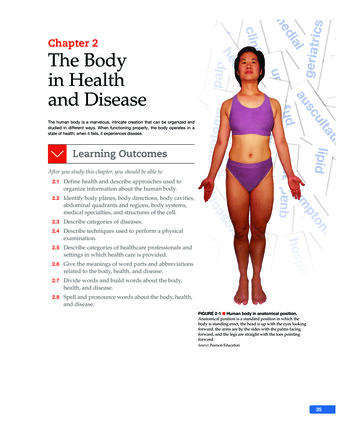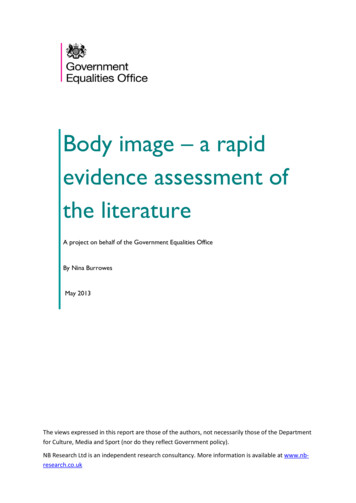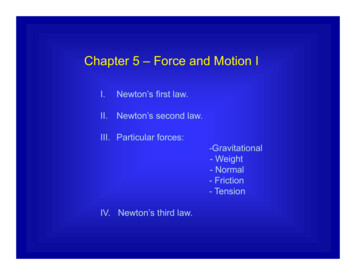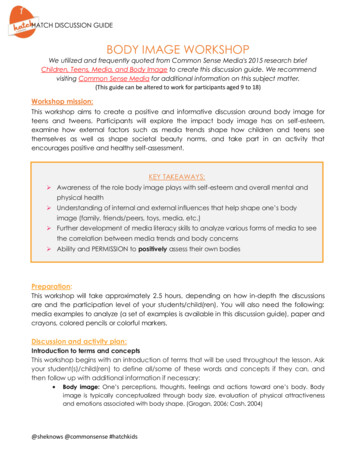
Transcription
Chapter 2The Bodyin Healthand DiseaseThe human body is a marvelous, intricate creation that can be organized andstudied in different ways. When functioning properly, the body operates in astate of health; when it fails, it experiences disease.Learning OutcomesAfter you study this chapter, you should be able to2.1 Define health and describe approaches used toorganize information about the human body.2.2 Identify body planes, body directions, body cavities,abdominal quadrants and regions, body systems,medical specialties, and structures of the cell.2.3 Describe categories of diseases.2.4 Describe techniques used to perform a physicalexamination.2.5 Describe categories of healthcare professionals andsettings in which health care is provided.2.6 Give the meanings of word parts and abbreviationsrelated to the body, health, and disease.2.7 Divide words and build words about the body,health, and disease.2.8 Spell and pronounce words about the body, health,and disease.Figure 2-1 Human body in anatomical position.Anatomical position is a standard position in which thebody is standing erect, the head is up with the eyes lookingforward, the arms are by the sides with the palms facingforward, and the legs are straight with the toes pointingforward.Source: Pearson Education35M02 TURL8127 04 SE C02.indd 3512/12/15 1:30 am
36Chapter 2 The Body in Health and DiseaseThe Body in HealthWhen the human body’s countless parts function correctly, the body is in astate of health. The World Health Organization defines health as a state ofcomplete physical, mental, and social well-being (and not just the absence ofdisease or infirmity). The healthy human body can be studied in several different ways.Each way approaches the body from a specific point of view and provides unique information by dividing or organizing the body in a logical way. These ways include:1. Body planes and body directions2. Body cavities3. Body quadrants and regions4. Anatomy and physiology5. Microscopic to macroscopic6. Body systems7. Medical specialties.Body Planes and Body DirectionsWhen the human body is in anatomical position (see Figure 2-1 ), it can be studied bydividing it with planes. A plane is an imaginary flat surface (like a plate of glass) thatdivides the body into two parts. There are three main body planes: the coronal plane,the sagittal plane, and the transverse plane. These planes divide the body into front andback, right and left, and upper and lower sections, respectively. Body directions represent movement away from or toward these planes.Coronal Plane and Body DirectionsThe coronal plane or frontal plane is a vertical plane that divides the body into frontand back sections (see Figure 2-2 ). The coronal plane is named for the coronal suturein the cranium (see Figure 2-3 ).The front of the body is the anterior or ventral section. The back of the body is theposterior or dorsal section. Lying face down is being in the prone position. Lying on theback is being in the dorsal or dorsal supine position.Moving toward the front of the body is moving in an anterior direction, or anteriorly. Moving toward the back of the body is moving in a posterior direction, or posteriorly (see Figure 2-4 ). The directions anterior and posterior can be combined asanteroposterior or posteroanterior. An anteroposterior (AP) direction moves from outside the body through the anterior section and then through the posterior section. Aposteroanterior (PA) direction moves from outside the body through the posterior section and then through the anterior section (see Figure 2-5 ).M02 TURL8127 04 SE C02.indd 36Pronunciation/Word Partshealth (HELTH)anatomical (an-ah-TAW-mih-kal)ana- apart; excessivetom/o- cut; layer; slice-ical pertaining toplane (PLAYN)coronal (kor-OH-nal)coron/o- structure that encircles like acrown-al pertaining tofrontal (FRUN-tal)front/o- front-al pertaining toanterior (an-TEER-ee-or)anter/o- before; front part-ior pertaining toventral (VEN-tral)ventr/o- abdomen; front-al pertaining toposterior (pohs-TEER-ee-or)poster/o- back part-ior pertaining todorsal (DOR-sal)dors/o- back; dorsum-al pertaining toprone (PROHN)supine (soo-PINE) r)anter/o- before; front partposter/o- back part-ior pertaining /o- back partanter/o- before; front part-ior pertaining to12/12/15 1:30 am
37Chapter 2 The Body in Health and talsutureFigure 2-2 Coronal plane.The coronal or frontal plane divides the body intoanterior (front) and posterior (back) sections.Source: Pearson EducationFigure 2-3 Coronal and sagittal sutures of the cranium.The coronal and sagittal planes are named for the coronal and sagittalsutures that join together the bones of the cranium. Each plane is oriented inthe same direction as the suture for which it is named.Source: Pearson EducationPosteriorAnteriorFigure 2-4 Anterior andposterior directions.Moving in an anterior directionis moving toward the front ofthe body. Moving in a posteriordirection is moving toward theback of the body. Anterior andposterior are opposite directions.Figure 2-5 Posteroanterior direction.Anteroposterior and posteroanterior are commonly used in radiology to indicate the path of anx-ray beam. For a posteroanterior (PA) chest x-ray, the x-ray beam enters the posterior chest, goesthrough the anterior chest, and enters the x-ray plate to produce an image.Source: Pearson EducationSource: Pearson EducationM02 TURL8127 04 SE C02.indd 3712/12/15 1:30 am
38Chapter 2 The Body in Health and DiseaseSagittal Plane and Body DirectionsPronunciation/Word PartsThe sagittal plane is a vertical plane that divides the body into right and left sections(see Figure 2-6 ). The sagittal plane is named for the sagittal suture in the cranium (seeFigure 2-3). If this plane divides the body at the midline into equal right and left sections, it is a midsagittal plane (see Figure 2-7 ).Moving from either side of the body toward the midline is moving in a medialdirection, or medially. Moving from the midline toward either side of the body is moving in a lateral direction, or laterally (see Figure 2-8 ). Bilateral indicates both sides.sagittal (SAJ-ih-tal)sagitt/o- front to back-al pertaining tomedial (MEE-dee-al)medi/o- middle-al pertaining tolateral (LAT-er-al)later/o- side-al pertaining tobilateral (by-LAT-er-al)bi- twolater/o- side-al pertaining toFigure 2-6 Sagittal plane.The sagittal plane divides the body into right and left sections.Figure 2-7 Midsagittal image of the head onan MRI scan.A magnetic resonance imaging (MRI) scan uses a magneticfield to create many individual images of the bodyin “slices.” This is an image of the head, taken in themidsagittal plane. The prefix mid- means middle. Otherimages taken during this scan would show “slices” alongmany parasagittal planes on either side of the midline. Oneof the meanings of the prefix para- is beside.Source: Pearson EducationSource: CGinspiration/ShutterstockM02 TURL8127 04 SE C02.indd 3812/12/15 1:30 am
Chapter 2 The Body in Health and DiseaseMedialMedialLateralLateral39MidlineFigure 2-8 Medial and lateral directions.Moving in a medial direction is moving toward the midline of the body.Moving in a lateral direction is moving away from the midline. Medialand lateral are opposite directions.Source: Pearson EducationFigure 2-9 Transverse plane.The transverse plane divides the body into superior (upper) andinferior (lower) sections.Source: Pearson EducationTransverse Plane and Body DirectionsPronunciation/Word PartsThe transverse plane is a horizontal plane that divides the body into upper and lowersections (see Figure 2-9 ). The upper half of the body is the superior section, and thelower half is the inferior section. Some anatomical structures have superior and inferiorparts (see Figure 2-10 ).transverse (trans-VERS)trans- across; through-verse travel; turnMost medical words contain a combiningform. The ending -verse contains thecombining form vers/o- and the one-lettersuffix -e.superior (soo-PEER-ee-or)super/o- above-ior pertaining toinferior (in-FEER-ee-or)infer/o- below-ior pertaining toSuperiorvena cavaHeartInferiorvena cavaM02 TURL8127 04 SE C02.indd 39Figure 2-10 Superior and inferior parts.The superior vena cava brings blood from the headto the heart. The inferior vena cava brings bloodfrom the lower body to the heart.Source: Pearson Education12/12/15 1:30 am
40Chapter 2 The Body in Health and DiseaseMoving toward the head is moving in a superior direction, or superiorly. This isalso the cephalad direction. Moving toward the tail bone is moving in an inferior direction, or inferiorly. This is also the caudad direction (see Figure 2-11 ).Pronunciation/Word Partscephalad (SEF-ah-lad)cephal/o- head-ad in the direction of; towardcaudad (KAW-dad)caud/o- tail bone-ad in the direction of; periorFigure 2-12 Distal and proximaldirections.Moving in a distal direction is movingaway from the trunk of the body (whereInferiorthe limb is attached) toward the fingersFigure 2-11 Cephalad and caudad directions.or toes. Moving in a proximal directionMoving in a cephalad direction is moving toward the head.is moving away from the fingers or toesMoving in a caudad direction is moving toward the tail bone. toward the trunk of the body. Distal andCephalad and caudad are opposite directions.proximal are opposite directions.Source: Pearson EducationSource: Pearson EducationOther Body Directions and LocationsMoving from the trunk of the body toward the end of a limb (arm or leg) is moving in adistal direction, or distally. Moving from the end of a limb toward the trunk of the bodyis moving in a proximal direction, or proximally (see Figure 2-12 ).Structures on the surface of the body are superficial or external. Structures belowthe surface and inside the body are deep or internal (see Figure 2-13 ).M02 TURL8127 04 SE C02.indd 40distal (DIS-tal)dist/o- away from the center; away fromthe point of origin-al pertaining toproximal (PRAWK-sih-mal)proxim/o- near the center; near thepoint of origin-al pertaining toexternal (eks-TER-nal)extern/o- outside-al pertaining tointernal (in-TER-nal)intern/o- inside-al pertaining to12/12/15 1:30 am
Chapter 2 The Body in Health and al(superficial)Figure 2-13 External and internal locations.External refers to the superficial or outer part of the body or an organ. Internal refers to deep inside thebody or an organ. Internal and external are opposite locations.Source: Pearson EducationBody CavitiesPronunciation/Word PartsThe human body can be studied according to its body cavities and their internal organs(see Figure 2-14 ). A cavity is a hollow space. It is surrounded by bones or muscles thatsupport and protect the organs and structures within the cavity. There are five bodycavities.The cranial cavity is within the bony cranium of the head. The cranial cavity contains the brain, cranial nerves, and related structures.The spinal cavity or spinal canal is a continuation of the cranial cavity as it travelsdown the midline of the back. The spinal cavity is within the bones of the spine. Thespinal cavity contains the spinal cord, spinal nerves, and related structures.cavity (KAV-ih-tee)cav/o- hollow space-ity condition; statecranial (KRAY-nee-al)crani/o- cranium; skull-al pertaining tospinal (SPY-nal)spin/o- backbone; spine-al pertaining tyDiaphragmAbdominalcavityPelviccavityFigure 2-14 Body cavities.The cranial cavity becomes the spinal cavity along theback. The thoracic cavity is separated from the abdominalcavity by the diaphragm. The abdominal cavity iscontinuous with the pelvic cavity and is often called theabdominopelvic cavity.Source: Pearson EducationM02 TURL8127 04 SE C02.indd 4112/12/15 1:31 am
42Chapter 2 The Body in Health and DiseaseThe thoracic cavity is within the chest and is surrounded by the breast bone (sternum) anteriorly, the ribs bilaterally, and the bones of the spine posteriorly. The thoraciccavity contains the lungs. The mediastinum—a smaller, central area within the thoraciccavity—contains the trachea, esophagus, heart, and related structures. The inferior border of the thoracic cavity is the large, muscular diaphragm that functions during respiration. The diaphragm separates the thoracic cavity from the abdominal cavity.The abdominal cavity is within the abdomen. It is surrounded by the diaphragmsuperiorly, the abdominal wall anteriorly, and the bones of the spine posteriorly. Thepelvic cavity is a continuation of the abdominal cavity. The pelvic cavity is surroundedby the pelvic (hip) bones anteriorly and bilaterally and the bones of the spine posteriorly. These two cavities are often called the abdominopelvic cavity because it is onecontinuous cavity with no dividing structure. The abdominopelvic cavity containsmany organs of the gastrointestinal, endocrine, reproductive, and urinary systems,such as the stomach, intestines, liver, gallbladder, pancreas, ovaries, uterus, and bladder. These large internal organs are the viscera.thoracic (thor-AS-ik)thorac/o- chest; thorax-ic pertaining toabdominal (ab-DAW-mih-nal)abdomin/o- abdomen-al pertaining topelvic (PEL-vik)pelv/o- hip bone; pelvis; renal pelvis-ic pertaining toabdominopelvic (ab-daw-mih-noh-PEL-vik)abdomin/o- abdomenpelv/o- hip bone; pelvis; renal pelvis-ic pertaining toviscera (VIS-er-ah)visceral (VIS-er-al)viscer/o- large internal organs-al pertaining toBody Quadrants and RegionsThe human body can be studied according to its quadrants and regions. The anteriorsurface of the abdominopelvic area can be divided into four quadrants or nine regions,both of which are helpful as references during a physical examination of the internalorgans.The four quadrants include the right upper quadrant (RUQ), left upper quadrant (LUQ), right lower quadrant (RLQ), and left lower quadrant (LLQ) (see Figure 2-15 ).Right upperquadrant (RUQ)Pronunciation/Word Partsquadrant (KWAH-drant)quadr/o- four-ant pertaining toLeft upperquadrant (LUQ)UmbilicusRight lowerquadrant (RLQ)Left lowerquadrant (LLQ)Figure 2-15 Quadrants of the abdominopelvic area.Four quadrants are formed when a horizontal line and a vertical linecross at the umbilicus (navel). The liver can be felt in the right upperquadrant, and the stomach in the left upper quadrant. A patient withappendicitis has pain in the right lower quadrant, and the rectum canbe felt in the left lower quadrant.Source: Pearson EducationM02 TURL8127 04 SE C02.indd 4212/12/15 1:31 am
43Chapter 2 The Body in Health and DiseasePronunciation/Word onLeftinguinalregionFigure 2-16 Regions of the abdominopelvic area.Nine regions are formed when two horizontal lines and two vertical linesform a square around the umbilicus.Source: Pearson EducationThe nine regions include the right and left hypochondriac regions, the epigastricregion, the right and left lumbar regions, the umbilical region (centered around theumbilicus or navel), the right and left inguinal regions, and the hypogastric region (seeFigure 2-16 ).Clinical ConnectionsThe lumbar regions of the abdominal area are so named because they are on the samelevel as the lumbar area of the lower back. Remember, when you are facing the patient (asin this illustration), your right side corresponds to the patient’s left side. Correctly identifyingright and left is an important patient safety issue.Did You Know?The Greeks considered the hypochondriac regions to be the seat of melancholy (sadfeelings) because they contained the liver and spleen, organs that were thought to releasesubstances that caused different moods. Today, a hypochondriac is a person who isconstantly concerned about real or imagined symptoms, many of which are in these regions.The anatomy of the human body was first studied by physicians who secretly carried awayand dissected the unclaimed dead bodies of criminals.Cells, Tissues, and OrgansThe human body can be studied according to its structures and functions. Anatomy isthe study of the structures of the human body. Physiology is the study of the functionsof those structures.The human body can be studied according to its smallest parts and how they combine to make larger and more complex structures and systems.M02 TURL8127 04 SE C02.indd 43hypochondriac (hy-poh-CON-dree-ak)hypo- below; deficientchondr/o- cartilage-iac pertaining toAdd words to make a complete definitionof hypochondriac: pertaining to below (the)cartilage (of the ribs).epigastric (ep-ih-GAS-trik)epi- above; upongastr/o- stomach-ic pertaining tolumbar (LUM-bar)lumb/o- area between the ribs andpelvis; lower back-ar pertaining toumbilical (um-BIL-ih-kal)umbilic/o- navel; umbilicus-al pertaining toinguinal (ING-gwih-nal)inguin/o- groin-al pertaining tohypogastric (hy-poh-GAS-trik)hypo- below; deficientgastr/o- stomach-ic pertaining toanatomy (ah-NAT-oh-mee)ana- apart; excessive-tomy process of cutting; process ofmaking an incisionThe ending -tomy contains the combiningform tom/o- and the one-letter suffix -y.physiology (fiz-ee-AW-loh-jee)physi/o- physical function-logy study of12/12/15 1:31 am
44Chapter 2 The Body in Health and DiseaseA cell is the smallest independently functioning structure in the body that canreproduce itself by division. All cells contain certain basic structures (see Figure 2-17 ).The cell membrane around the cell is a permeable barrier that protects and supportsthe intracellular contents. It allows water and nutrients to enter the cell and cellularwaste products to leave the cell. It also contains ion pumps that actively bring electrolytes (sodium, potassium, and so forth) in and out of the cell.The cytoplasm is a gel-like substance that fills the cell. The cytoplasm contains several different types of structures known as organelles. Endoplasmic reticulum. Network of channels throughout the cytoplasm that transports materials. It is also the site of protein, fat, and glycogen production. Golgi apparatus. Curved, stacked membranes that process and store proteins (suchas hormones or enzymes) until they are released by the cell. It also makes lysosomes. Lysosomes. Small sacs that contain powerful digestive enzymes to destroy a bacterium or virus that invades the cell. When a cell dies, the lysosomes release theirenzymes into the cytoplasm, and the cell is slowly dissolved. Messenger RNA. Messenger RNA (ribonucleic acid) duplicates the informationcontained in a gene and carries it to the ribosome where it is used to assembleamino acids to make a protein molecule. Mitochondria. Capsule-shaped structures with sectioned chambers that produceand store ATP, a high-energy molecule obtained from the metabolism of glucose. Asneeded, the mitochondria convert ATP to ADP to release energy for cellular activities. Nucleus. Large, round, centralized structure that is surrounded by a membrane.The nucleus controls all of the activities that take place within the cell. The nucleolus is a round, central region within the nucleus. It produces RNA and ribosomes.Chromosomes are paired structures within the nucleus. Each cell nucleus contains23 pairs of chromosomes for a total of 46 chromosomes. In each of the 23 pairs, oneof the chromosomes was inherited from the mother and the other from the father.A single chromosome is made of one long DNA (deoxyribonucleic acid) molecule.A DNA molecule consists of repeating pairs of amino acids sequenced along twostrands that form a double helix.CellmembraneCytoplasmPronunciation/Word Partscell (SEL)cellular (SEL-yoo-lar)cellul/o- cell-ar pertaining toThe combining form cyt/o- also means cell.intracellular (in-trah-SEL-yoo-lar)intra- withincellul/o- cell-ar pertaining tocytoplasm (SY-toh-plazm)cyt/o- cell-plasm formed substance; growthorganelle (or-gah-NEL)organ/o- organ-elle small thingendoplasmic (en-doh-PLAS-mik)endo- innermost; withinplasm/o- plasma-ic pertaining toreticulum (reh-TIH-kyoo-lum)Golgi (GOL-jee)lysosome (LY-soh-sohm)lys/o- break down; destroy-some bodyAdd words to make a complete definitionof lysosome: body (that contains enzymesthat) break down or destroy.ribonucleic acid(ry-boh-noo-KLEE-ik AS-id)mitochondrion (my-toh-CON-dree-on)mitochondria (my-toh-CON-dree-ah)Mitochondrion is a Greek singular noun.Form the plural by changing -on to -a.nucleus sosomeEndoplasmicreticulumMitochondrionnuclei (NOO-klee-eye)Nucleus is a Latin singular noun. Form theplural by changing -us to -i. The combiningform kary/o- means nucleus of a cell.nuclear (NOO-klee-ar)nucle/o- nucleus of an atom; nucleusof a cell-ar pertaining tonucleolus (noo-KLEE-oh-lus)GolgiapparatusFigure 2-17 Structures of a cell.A cell consists of many different structures, each of which plays a unique role in securing nutrients,producing energy, building proteins, and fighting invading pathogens. All of these functions are essentialto the continuing health of the body.nucleoli (noo-KLEE-oh-lie)Nucleolus is a Latin singular noun. Form theplural by changing -us to -i.chromosome (KROH-moh-sohm)chrom/o- color-some bodyAdd words to make a complete definitionof chromosome: (microscopic) body (thattakes on) color (when stained).Source: Pearson EducationM02 TURL8127 04 SE C02.indd 4412/12/15 1:31 am
45Chapter 2 The Body in Health and DiseaseA gene is one segment of a DNA molecule that contains enough amino acid pairs toprovide the information needed to produce one protein molecule. In a cell that is notdividing, each long DNA molecule is loosely coiled, giving the nucleus a woven, grainyappearance under the microscope. As the cell prepares to divide, each DNA moleculecoils tightly, making the chromosomes visible as rodlike structures in the nucleus.Pronunciation/Word Partsdeoxyribonucleic acid(dee-awk-see-ry-boh-noo-KLEE-ik AS-id)gene (JEEN) Ribosomes. Granular structures in the cytoplasm and on the endoplasmic reticulum.Ribosomes contain RNA and proteins and are the site where proteins are produced.genetic (jeh-NET-ik)gene/o- gene-tic pertaining toDid You Know?ribosome (RY-boh-sohm)rib/o- ribonucleic acid-some bodyMost body cells contain one nucleus. However, a mature erythrocyte (red blood cell) doesnot contain any nucleus, and a skeletal muscle cell contains many nuclei.Mitosis is the process by which a cell divides. Mitosis begins in the cell’s nucleusas each chromosome makes an exact copy of itself. (The double helix of its DNA molecule splits down its length and rebuilds to form another double helix.) All of the chromosomes and their identical copies align themselves along thread-like strands in thenucleus and then separate to opposite sides of the nucleus. Then the entire nucleus andcytoplasm split, forming two cells that are identical to the original cell.Most cells and cellular structures are microscopic in size and can be seen onlythrough a microscope (see Figure 2-18 ), although some cells—a female ovum, forexample—can be seen with the naked eye. Cells combine to form tissues, and tissuescombine to form organs. (Different kinds of tissues and organs are discussed in specific chapters.) Tissues and organs are macroscopic and can be seen with the naked eye.Organs combine to form a body system. The human body contains many different bodysystems, as discussed in the next section.MACROSCOPICmitosis (my-TOH-sis)mit/o- thread-like structure-osis condition; processAdd words to make a complete definitionof mitosis: process (of cell division duringwhich the chromosomes align along)thread-like structures (in the nucleus).microscopic (my-kroh-SKAW-pik)micr/o- one millionth; smallscop/o- examine with an instrument-ic pertaining tomicroscope (MY-kroh-skohp)micr/o- one millionth; small-scope instrument used to examineA microscope is an instrument used toexamine small (things). Note: To definethis word correctly, you must start withthe meaning of the suffix followed by themeaning of the combining form. If not,you will get the incorrect definition of smallinstrument used to examine (things).tissue (TIH-shoo)organ (OR-gan)macroscopic (mak-roh-SKAW-pik)macr/o- largescop/o- examine with an instrument-ic pertaining toMICROSCOPICFigure 2-18 Using a microscope to study the human body.A microscope enhances our understanding of the human body because it allows us to see anatomicalstructures not visible to the naked eye. With its magnification, we can see cells and even tiny structureswithin cells.Source: Pearson Education; Darren Baker/FotoliaM02 TURL8127 04 SE C02.indd 4512/12/15 1:31 am
46Chapter 2 The Body in Health and DiseaseBody SystemsPronunciation/Word PartsThe human body can be studied according to its structures and how they functiontogether as a body system. Studying the body systems is the standard approach usedin anatomy and physiology textbooks. However, in medicine, body systems are studiedwithin the context of medical specialties. Because this textbook is about medical language, we will study by medical specialties, just as in the real world of medicine!system (SIS-tem)Medical SpecialtiesThe human body can be studied according to the medical specialties that make upthe practice of medicine. Each medical specialty includes the anatomy (structures),physiology (functions), diseases, laboratory and diagnostic procedures, medical andsurgical procedures, and drugs for a particular body system. Medical specialties (notbody systems) are used to name departments in the hospital and other medical facilities(example: the Department of Cardiology).Medical Specialty and Body er 3)Source: Pearson EducationGastroenterologyis the study ofthe stomach andintestines (andrelated structures).A gastroenterologist is a physicianwho specializes apter 4)Source: Pearson EducationM02 TURL8127 04 SE C02.indd 46Pulmonology isthe study of thelungs (and relatedstructures). Apulmonologist isa physician whospecializes inpulmonology.Structuresmedical (MED-ih-kal)medic/o- medicine; physician-al pertaining toFunctionsPronunciation/Word Parts mouth (teeth andtongue) salivary glands pharynx (throat) esophagus stomach small intestine large intestine liver gallbladder pancreas receive sensoryinformation (taste) digest food absorb nutrients intothe blood excrete W-loh-jee)gastr/o- stomachenter/o- intestine-logy study of nose pharynx (throat) larynx (voice box) trachea bronchi bronchioles alveoli (in the lungs) inhale oxygen exhale carbon dioxide exchange gases in - lung-logy study - stomachintestin/o- intestine-al pertaining ee)re- again and again;backward; unable tospir/o- breathe; coil-atory pertaining to12/12/15 1:31 am
47Chapter 2 The Body in Health and DiseaseMedical Specialty and Body SystemCardiologyCardiovascularSystem(Chapter 5)Source: Pearson EducationStructures heart arteries veins capillariesImmunologyBlood, LymphaticSystem(Chapter 6)Immunology isthe study of theimmune response.An immunologistis a physicianwho specializes r 7)M02 TURL8127 04 SE C02.indd 47Dermatology isthe study of theskin (and relatedstructures). Adermatologist isa physician whospecializes indermatology.Pronunciation/Word Partscardiology(kar-dee-AW-loh-jee)cardi/o- heart-logy study ofcardiovascular(kar-dee-oh-VAS-kyoo-lar)cardi/o- heartvascul/o- blood vessel-ar pertaining to transport oxygen andnutrients to the cells transport carbondioxide to the lungsand wastes to thekidneyshematology(hee-mah-TAW-loh-jee)hemat/o- blood-logy study of lymphatic vessels,lymph nodes, andlymph fluid spleen thymus white blood cells recognize anddestroy diseasecausing organismsand abnormal cellsimmunology(ih-myoo-NAW-loh-jee)immun/o- immuneresponse-logy study of skin hair nails sweat glands oil glands receive sensoryinformation (pain,touch, temperature) protect internal organs regulate bodytemperature bysweating blood (blood cellsand plasma)Hematology is thestudy of the blood.A hematologist isa physician whospecializes inhematology.Source: Pearson Education circulate bloodthroughout the bodyCardiology isthe study of theheart (and relatedstructures). Acardiologist is aphysician whospecializes incardiology.HematologyBlood (Chapter 6)Source: Pearson EducationFunctionsblood (BLUD)lymphatic (lim-FAT-ik)lymph/o- lymph; lymphaticsystem-atic pertaining todermatology(der-mah-TAW-loh-jee)dermat/o- skin-logy study /o- skin-ary pertaining to12/12/15 1:31 am
48Chapter 2 The Body in Health and DiseaseMedical Specialty and Body SystemOrthopedicsSkeletal System(Chapter 8)Source: Pearson EducationStructures bones cartilage ligaments jointsFunctions support the bodyOrthopedics isthe knowledgeand practiceof producingstraightness ofthe bones andmuscles in achild or adult. Anorthopedist is aphysician whospecializes inorthopedics.Pronunciation/Word Partsorthopedics(or-thoh-PEE-diks)orth/o- straightped/o- child-ics knowledge; practiceAdd words to make acomplete definition oforthopedics: knowledgeand practice (of producing)straight(ness of the bonesand muscles in a) child (oradult).skeletal (SKEL-eh-tal)skelet/o- skeleton-al pertaining toOrthopedicsMuscular System(Chapter 9) muscles tendons produce movement ofthe bodymuscular (MUS-kyoo-lar)muscul/o- muscle-ar pertaining toNeurologyNervous System(Chapter 10) brain cranial nerves spinal c
The Body in Health W hen the human body’s countless parts function correctly, the body is in a state of health. The World Health Organization defines health as a state of complete physical, mental, and social well-being (and not just the absence of disease or infirmity). The healthy huma











